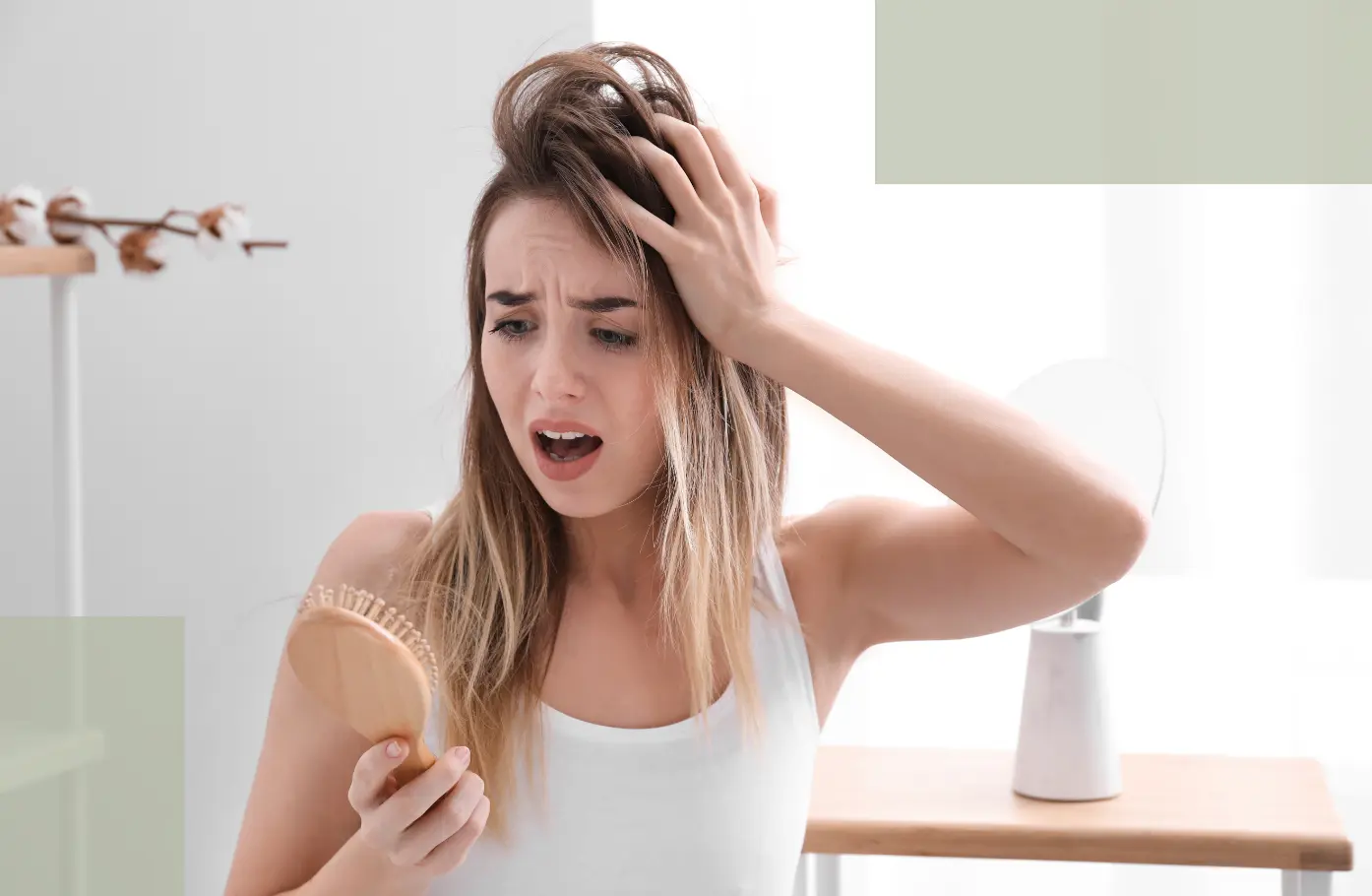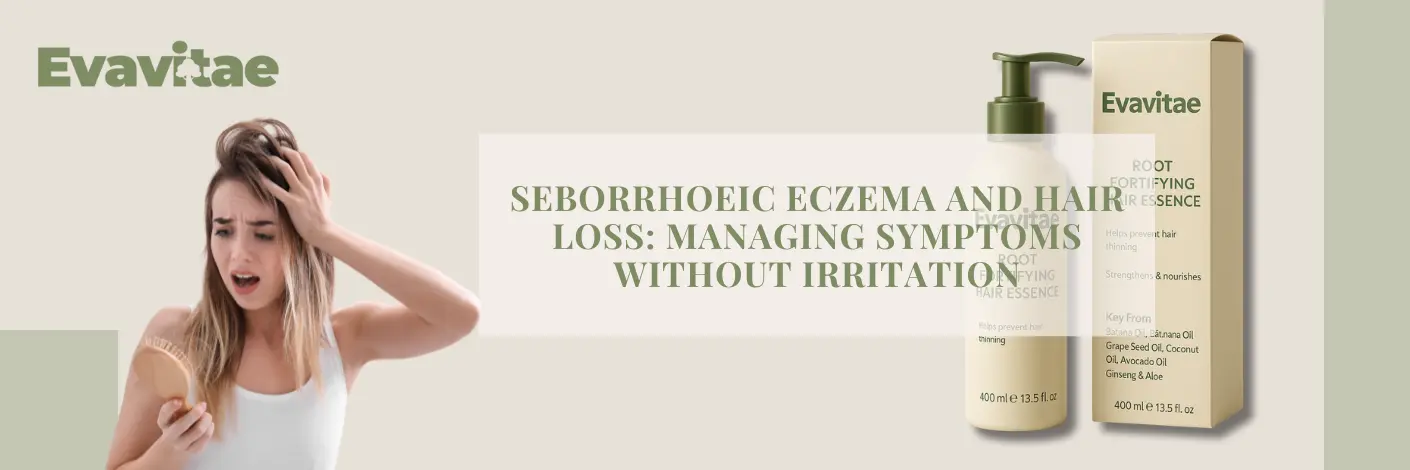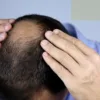
Seborrhoeic eczema—also known as seborrhoeic dermatitis—is a chronic inflammatory skin condition that commonly affects areas rich in oil-secreting glands, such as the scalp. Fish-like yellowish or white flakes, itchiness, redness, and oily patches are hallmark symptoms. While the condition doesn’t directly cause hair loss, it can create an environment where hair thinning becomes a logical consequence.
In this article, we’ll dig into how seborrhoeic eczema can contribute to hair loss, how to differentiate it from other scalp issues, and most importantly, how to manage it effectively and gently—so your scalp heals without irritation.
What Drives Hair Loss in Seborrhoeic Eczema?
Overactive Sebum + Malassezia Imbalance
Seborrhoeic eczema develops where sebum (oil) production is naturally higher. When too much oil mixes with the Malassezia yeast—normally present on the scalp—it can trigger an immune reaction. This leads to inflammation, flaking, and itching. Research suggests that this imbalance compromises the scalp barrier, potentially hindering hair’s ability to grow normally.
Scratching-Induced Trauma
The intensified itchiness often leads to repetitive scratching, which damages the hair follicles. Over time, this can result in hair breakage and visible thinning.
Temporary Interference with Hair Growth
Chronic inflammation and disrupted scalp health can push hair follicles into the shedding (telogen) phase prematurely. Though distressing, this process is often reversible if the underlying eczema is managed correctly.
How to Recognize the Difference: Seborrhoeic Eczema vs. Dandruff vs. Scalp Psoriasis
Recognizing the right condition is the first step toward effective care:
- Dandruff: Flakes without redness, typically less oily.
- Seborrhoeic Eczema: Greasy, yellowish flakes, red patches, and persistent itching.
- Psoriasis: Thick silvery scales, sharply demarcated patches—often with less itch but more physical barrier disruption.
Correct identification helps avoid misusing harsh treatments that could worsen symptoms.
Gentle Strategies to Support Hair Regrowth
1. Rotate Medicated and Gentle Shampoos
Use an anti-fungal shampoo (ketoconazole, zinc pyrithione, selenium sulfide) 1–2 times weekly to reduce Malassezia. Alternate with a sulfate-free, fragrance-free shampoo formulated for sensitive scalps(try Evavitae) to prevent over-drying the skin.
2. Avoid Irritating Additives
Steer clear of shampoos containing sulfates, artificial fragrances, or harsh alcohols(Evavitae shampoo does a great job of this; see its ingredient list). These ingredients strip the scalp of its natural oils, intensifying flaking and itchiness.
3. Support the Scalp Barrier with Emollients
Moisturizing oils like jojoba or rice bran can soothe and restore the scalp barrier. Avoid pore-clogging or heavily perfumed oils, especially during flares.
4. Use Anti-inflammatory Shampoos Smartly
For mild relieving effects, consider formulas with salicylic acid or coal tar—but use sparingly and rinse thoroughly. These can help remove flakes without stripping moisture.
5. Carefully Consider Corticosteroid Combinations
Short-term use of topical corticosteroids—under dermatological guidance—can calm severe inflammation. Always follow medical advice to avoid long-term side effects.
6. Lifestyle Matters
Manage stress, avoid excessive sun exposure, and opt for a balanced diet with omega-3s and antioxidants to support scalp health naturally.
Real-World Hair Recovery: What to Expect
With consistent gentle care:
- Itching and flakiness may reduce within 1–2 weeks
- Visible shedding often decreases within 4–6 weeks
- Hair regrowth can resume after a 3-month maintenance period
For persistent or painful flare-ups, consult a dermatologist for combined treatments—including light therapy or longer-term topical care.
Deeper Look: How Scalp Ecology Shapes Hair Health
Our scalp isn’t just skin with hair—it’s an ecosystem. A balanced environment of natural oils, skin barrier proteins, and microorganisms keeps hair follicles in the active (anagen) growth phase.
When seborrhoeic eczema disrupts this ecosystem, two major things happen:
- Sebum quality changes: Instead of lubricating and protecting the scalp, excessive or altered sebum composition becomes a breeding ground for Malassezia yeast, intensifying inflammation (Borda & Wikramanayake, 2015).
- Barrier protein depletion: Key proteins like filaggrin and loricrin—which keep skin cells tightly packed—are weakened. This makes the scalp more vulnerable to environmental triggers, leading to chronic flare-ups.
This constant cycle of irritation and repair diverts energy from hair production, often causing weaker hair shafts and slower growth.
Once inflammation is under control, consistency becomes the key to long-term scalp comfort. Learn how to build an effective daily shampoo routine for scalp balance—a gentle, structured approach that helps reduce flare-ups while supporting healthy hair regrowth.
Hidden Everyday Triggers
Many people with seborrhoeic eczema unintentionally make it worse through daily habits:
- Overwashing or Underwashing
- Washing too often with harsh cleansers strips protective oils, causing rebound oil production.
- Washing too rarely allows yeast and oil to accumulate, fueling inflammation.
- Seasonal Changes
- Cold, dry winters reduce skin hydration, worsening flakiness.
- Hot, humid summers increase sweating and oil production, creating a perfect storm for yeast overgrowth.
- Hair Product Buildup
- Leave-in styling products with silicones, heavy waxes, or fragrances can trap oil and irritants against the scalp.
- Nutrient Gaps
- Deficiencies in zinc, vitamin D, and essential fatty acids can slow the scalp’s natural repair process (Healthline, 2018).
Long-Term Maintenance: Breaking the Relapse Cycle
Seborrhoeic eczema tends to be chronic but manageable. The goal isn’t just to treat flare-ups but to prevent them.
- Set a Scalp Routine: Use a gentle shampoo 2–3 times weekly, supplemented with anti-fungal washes once weekly during flare seasons.
- Barrier-Friendly Oils: Light oils like jojoba or squalane can be massaged into the scalp overnight once a week to maintain hydration without clogging follicles.
- Microbiome Support: Emerging research suggests that topical probiotics may help restore balance—though still experimental, it’s a promising field (Borda & Wikramanayake, 2015).
- Mind the Stress Factor: Stress hormones can alter sebum composition and immune response. Yoga, meditation, or short daily walks can make a real difference.
When to Seek Medical Guidance
While mild seborrhoeic eczema can often be managed at home, there are situations where professional help is essential:
- Persistent pain or burning sensation
- Signs of secondary infection (oozing, pus, or spreading redness)
- Rapid or patchy hair loss in a short time frame
Dermatologists can offer advanced therapies, from low-dose antifungal treatments to light therapy that reduces inflammation without harsh chemicals.
Empowerment Through Understanding
Perhaps the most important takeaway is this: seborrhoeic eczema-related hair loss is rarely permanent. Understanding the mechanisms, avoiding common pitfalls, and sticking to a gentle yet consistent care routine will help you keep your scalp healthy in the long term.
By seeing seborrhoeic eczema not as a random flare-up but as a condition you can influence daily, you shift from feeling helpless to being in control. And that’s the first step toward both scalp comfort and renewed hair growth.
❤️ Final Thoughts
Experiencing hair shedding due to seborrhoeic eczema is unsettling—but it’s not permanent. By combining the right treatments with gentle care and avoiding irritants, you can soothe your scalp and pave the way for healthier hair regrowth.
Let your focus be on consistency—not harsh fixes—and your scalp will respond positively in time.
✨ For gentle, everyday habits that keep your scalp balanced, visit the Scalp Care & Routine Hub.
Learn how to stop shedding and encourage growth naturally in our Postpartum Hair Regrowth Guide.
📚 References (APA Format)
American Academy of Dermatology Association. (n.d.). Seborrheic dermatitis: Symptoms and management. Retrieved from https://www.aad.org
Borda, L. J., & Wikramanayake, T. C. (2015). Seborrheic dermatitis and dandruff: A comprehensive review. Skin Appendage Disorders, 1(4), 179–187. https://doi.org/10.1159/000441937
Cleveland Clinic. (2024). Seborrheic dermatitis: Symptoms, causes & treatment. Retrieved from https://my.clevelandclinic.org/health/diseases/14403-seborrheic-dermatitis
Healthline. (2018). Seborrheic dermatitis and hair loss. Retrieved from https://www.healthline.com/health/seborrheic-dermatitis-hair-loss
Evavitae products are now available exclusively at www.evavitae.com.




Add comment
You must be logged in to post a comment.